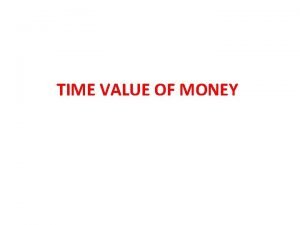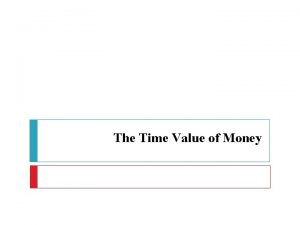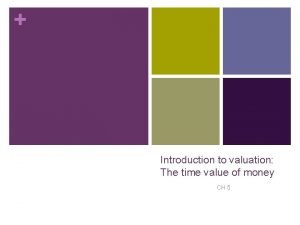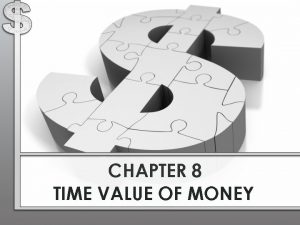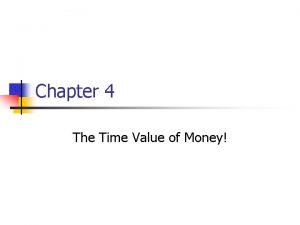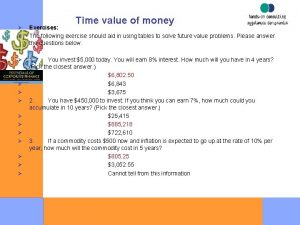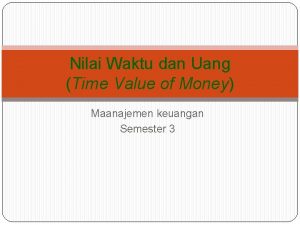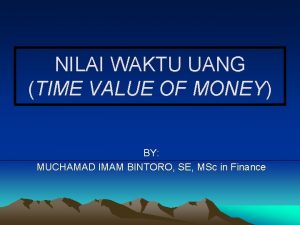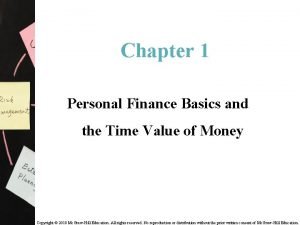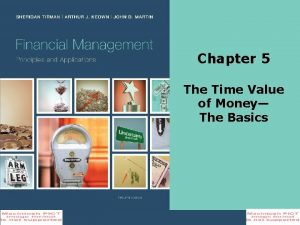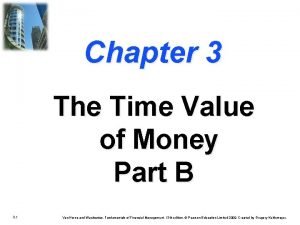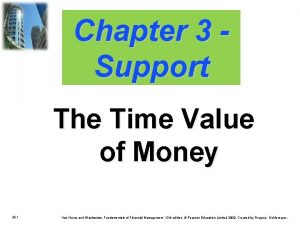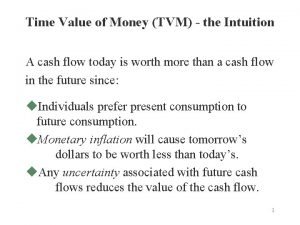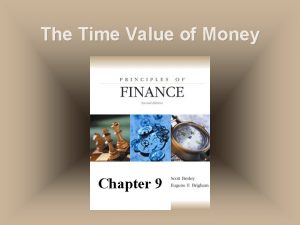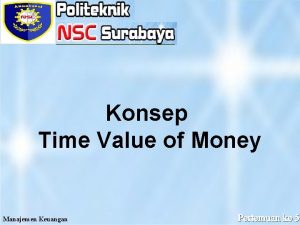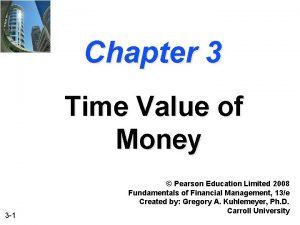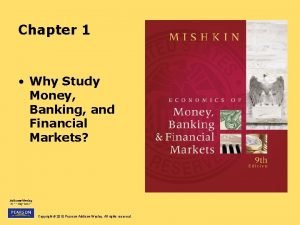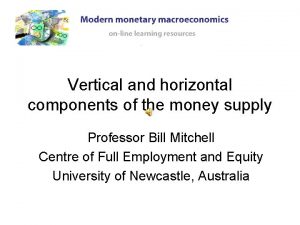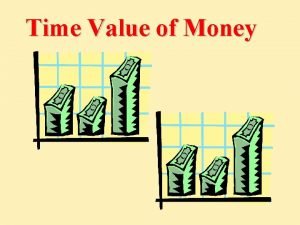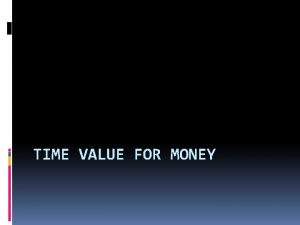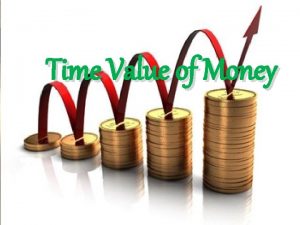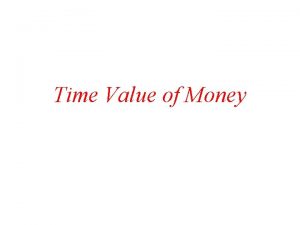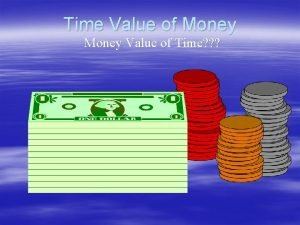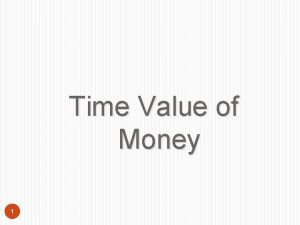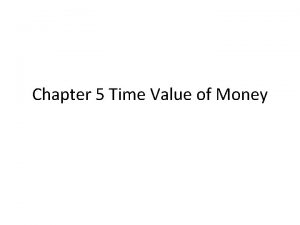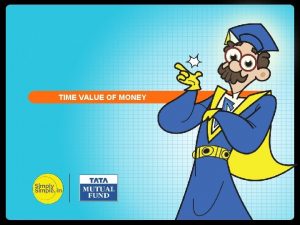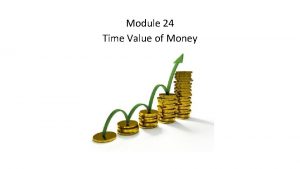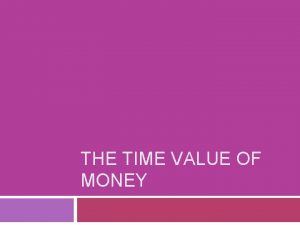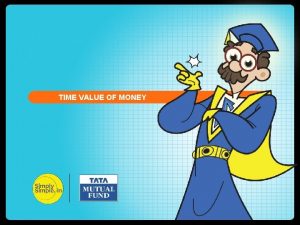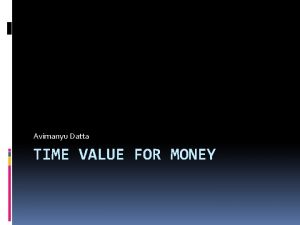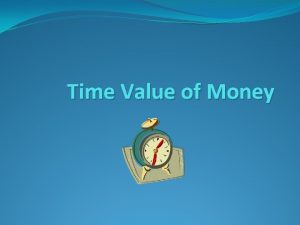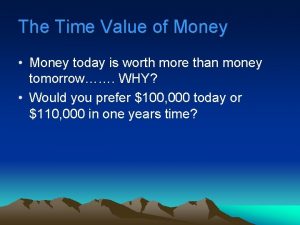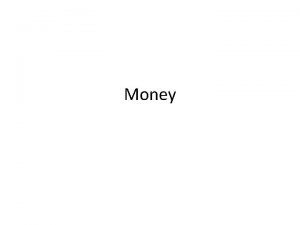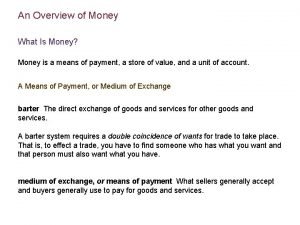TIME VALUE OF MONEY WHY TIME VALUE A













![PRESENT VALUE OF A SINGLE AMOUNT PV = FVn [1/ (1 + r)n] n/r PRESENT VALUE OF A SINGLE AMOUNT PV = FVn [1/ (1 + r)n] n/r](https://slidetodoc.com/presentation_image_h/cdc33878a0b6142f44c4ef5d829d7ab6/image-14.jpg)














- Slides: 28

TIME VALUE OF MONEY

WHY TIME VALUE A rupee today is more valuable than a rupee a year hence. Why ? • Preference for current consumption over future consumption • Productivity of capital • Inflation Many financial problems involve cash flows occurring at different points of time. For evaluating such cash flows, an explicit consideration of time value of money is required

Why TIME? Why is TIME such an important element TIME in your decision? TIME allows you the opportunity to TIME postpone consumption and earn INTEREST

Types of Interest u Simple Interest u Interest paid (earned) on only the original amount, or principal, borrowed (lent). Compound Interest paid (earned) on any previous interest earned, as well as on the principal borrowed (lent).

Simple Interest Formula SI = SI: P 0: i: n: P 0(i)(n) Simple Interest Deposit today (t=0) Interest Rate per Period Number of Time Periods

Simple Interest Example Assume that you deposit $1, 000 in an account earning 7% simple interest for 2 years. What is the accumulated interest at the end of the 2 nd year? SI = P 0(i)(n) = $1, 000(. 07)(2) = $140

Simple Interest (FV) What is the Future Value ( Future Value FV) of the deposit? FV FV = P 0 + SI = $1, 000 + $140 = $1, 140 Future Value is the value at some future time of a present amount of money, or a series of payments, evaluated at a given interest rate.

Simple Interest (PV) What is the Present Value ( Present Value PV) of the previous PV problem? The Present Value is simply the $1, 000 you originally deposited. That is the value today! Present Value is the current value of a future amount of money, or a series of payments, evaluated at a given interest rate.

DOUBLING PERIOD Thumb Rule : Rule of 72 Doubling period = Interest rate : 15 percent 72 Doubling = period 15 4. 8 years A more accurate thumb rule : Rule of 69 Doubling period = 0. 35 + Interest rate : 15 percent 69 Doubling period = 0. 35 + 15 = 4. 95 years

NOTATION PV : Present value FVn : Future value n years hence Ct : Cash flow occurring at the end of year t A : A stream of constant periodic cash flow over a given time r : Interest rate or discount rate g : Expected growth rate in cash flows n : Number of periods over which the cash flows occur.

FUTURE VALUE OF A SINGLE AMOUNT Rs First year: Principal at the beginning Interest for the year (Rs. 1, 000 x 0. 10) Principal at the end 1, 000 Principal at the beginning Interest for the year (Rs. 1, 100 x 0. 10) Principal at the end 1, 100 Principal at the beginning Interest for the year (Rs. 1, 210 x 0. 10) Principal at the end 1, 210 100 1, 100 Second year: Third year: 110 1, 210 121 1, 331 FORMULA FUTURE VALUE = PRESENT VALUE (1+r)n

Q. You deposit Rs. 20, 000 in a savings account that pays 10 percent interest, compounded annually. How much will your account be worth in 15 years? Ans. Money in the a/c after 15 years will be Rs, 2, 000 x FVIF(10%, 15 years)= Rs. 2000 x 4. 177 = Rs. 83, 540

VALUE OF FVIFr, n FOR VARIOUS COMBINATIONS OF r AND n n/r 6 % 8 % 10 % 12 % 2 1. 124 1. 166 1. 210 1. 254 1. 300 4 1. 262 1. 361 1. 464 1. 574 1. 689 6 1. 419 1. 587 1. 772 1. 974 2. 195 8 1. 594 1. 851 2. 144 2. 476 2. 853 10 1. 791 2. 518 2. 594 3. 106 3. 707
![PRESENT VALUE OF A SINGLE AMOUNT PV FVn 1 1 rn nr PRESENT VALUE OF A SINGLE AMOUNT PV = FVn [1/ (1 + r)n] n/r](https://slidetodoc.com/presentation_image_h/cdc33878a0b6142f44c4ef5d829d7ab6/image-14.jpg)
PRESENT VALUE OF A SINGLE AMOUNT PV = FVn [1/ (1 + r)n] n/r 6% 8% 10% 12% 14% 2 0. 890 0. 857 0. 826 0. 797 0. 770 4 0. 792 0. 735 0. 683 0. 636 0. 592 6 0. 705 0. 630 0. 565 0. 507 0. 456 8 0. 626 0. 540 0. 467 0. 404 0. 351 10 0. 558 0. 463 0. 386 0. 322 0. 270 12 0. 497 0. 397 0. 319 0. 257 0. 208

Q. You can earn 8 percent interest, compounded annually. How much must you deposit today to withdraw Rs. 10, 000 in 6 years? Ans. The amount of deposit as on today will be Rs. 10, 000 x PVIF( 8%, 6 years)= Rs. 10, 000 x 0. 630 = Rs. 6300

PRESENT VALUE OF AN UNEVEN SERIES A 1 A 2 An PVn = + + …… + (1 + r)2 (1 + r)n n At = t =1 (1 + r)t Year Rs. Cash Flow PVIF 12%, n Present Value of Individual Cash Flow 1 1, 000 0. 893 2 2, 000 0. 797 3 2, 000 0. 712 4 3, 000 0. 636 5 3, 000 0. 567 6 4, 000 0. 507 7 4, 000 0. 452 8 5, 000 0. 404 Present Value of the Cash Flow Stream 893 1, 594 1, 424 1, 908 1, 701 2, 028 1, 808 2, 020 13, 376

FUTURE VALUE OF AN ANNUITY An annuity is a series of periodic cash flows (payments and receipts ) of equal amounts 1 1, 000 2 3 4 1, 000 5 1, 000 + 1, 100 + 1, 210 + 1, 331 + 1, 464 Rs. 6, 105 Future value of an annuity = A [(1+r)n-1] r

Q. What is the future value of a 5 -year ordinary annuity with annual payments of Rs. 200, evaluated at a 15 percent interest rate? Ans. Future value of a 5 -year ordinary annuity will be: Rs. 200 x FVIFA(15%, 5 years)= Rs. 200 x 6. 742=Rs. 1. 348. 40

WHAT LIES IN STORE FOR YOU Suppose you have decided to deposit Rs. 30, 000 per year in your Public Provident Fund Account for 30 years. What will be the accumulated amount in your Public Provident Fund Account at the end of 30 years if the interest rate is 11 percent ? The accumulated sum will be : Rs. 30, 000 (FVIFA 11%, 30 yrs) = Rs. 30, 000 (1. 11)30 - 1 . 11 = Rs. 30, 000 [ 199. 02] = Rs. 5, 970, 600

HOW MUCH SHOULD YOU SAVE ANNUALLY You want to buy a house after 5 years when it is expected to cost Rs. 2 million. How much should you save annually if your savings earn a compound return of 12 percent ? The future value interest factor for a 5 year annuity, given an interest rate of 12 percent, is : (1+0. 12)5 - 1 FVIFA n=5, r =12% = 0. 12 The annual savings should be : Rs. 2000, 000 = Rs. 314, 812 6. 353 = 6. 353

FINDING THE INTEREST RATE A finance company advertises that it will pay a lump sum of Rs. 8, 000 at the end of 6 years to investors who deposit annually Rs. 1, 000 for 6 years. What interest rate is implicit in this offer? The interest rate may be calculated in two steps : 1. Find the FVIFAr, 6 for this contract as follows : Rs. 8, 000 = Rs. 1, 000 x FVIFAr, 6 = Rs. 8, 000 = 8. 000 Rs. 1, 000 2. Look at the FVIFAr, n table and read the row corresponding to 6 years until you find a value close to 8. 000. Doing so, we find that FVIFA 12%, 6 is 8. 115. So, we conclude that the interest rate is slightly below 12 percent.

ANNUITY Fixed amount of money Received or paid For a particular period of time

PRESENT VALUE OF ANNUITY Q. What is the present value of a 5 -year ordinary annuity with annual payments of Rs. 200, evaluated at a 15 percent interest rate? Ans. Present value of a 5 -year ordinary annuity will be: Rs. 200 x PVIFA(15%, 5 years)= Rs. 200 x 3. 352= Rs. 670. 40

LOAN AMORTISATION SCHEDULE Loan : 1, 000 r = 15%, n = 5 years 1, 000 = A x PVAn =5, r =15% = A x 3. 3522 A = 298, 312 Year Beginning Annual Interest Amount Instalment Repayment Balance (1) (2) 1 1, 000 298, 312 150, 000 148, 312 851, 688 298, 312 127, 753 170, 559 681, 129 3 681, 129 298, 312 102, 169 196, 143 484, 986 4 484, 986 298, 312 727, 482 225, 564 259, 422 5 259, 422 298, 312 38, 913 259, 399 23* a Interest is calculated by multiplying the beginning loan balance by the interest rate. (3) Principal Remaining (2)-(3) = (4) (1)-(4) = (5) b. Principal repayment is equal to annual instalment minus interest. * Due to rounding off error a small balance is shown

PRESENT VALUE OF PERPETUITY- is an annuity with infinite time period. A Present value of perpetuity = i A= Annual Receipt or Payment i = Interest rate

Q. You have the opportunity to buy a perpetuity which pays Rs. 1, 000 annually. Your required rate of return on this investment is 15 percent. At what price will you be interested in buying the investment? Ans. Price at which the investment should be purchased will be: Rs. 1000 = Rs. 6, 666. 67 0. 15

SHORTER COMPOUNDING PERIOD Future value = Present value 1+ r mxn m Where r = nominal annual interest rate m = number of times compounding is done in a year n = number of years over which compounding is done Example : Rs. 5000, 12 percent, 4 times a year, 6 years 5000(1+ 0. 12/4)4 x 6 = 5000 (1. 03)24 = Rs. 10, 164

EFFECTIVE VERSUS NOMINAL RATE r = (1+k/m)m – 1 r = effective rate of interest k = nominal rate of interest m = frequency of compounding per year Example : k = 8 percent, m=4 r = (1+. 08/4)4 – 1 = 0. 0824 = 8. 24 percent Nominal and Effective Rates of Interest Effective Rate % Nominal Annual Semi-annual Quarterly Monthly Rate % Compounding 8 8. 00 8. 16 8. 24 8. 30 12. 00 12. 36 12. 55 12. 68
 Money money money team
Money money money team Pictures
Pictures Rumus present value annuity
Rumus present value annuity Objectives of time value of money
Objectives of time value of money Introduction to valuation the time value of money
Introduction to valuation the time value of money Chapter 8 time value of money answer key
Chapter 8 time value of money answer key Time value of money quiz
Time value of money quiz Time value of money exercise
Time value of money exercise Anuitas adalah
Anuitas adalah Diskusi tentang time value of money
Diskusi tentang time value of money Personal finance basics and the time value of money
Personal finance basics and the time value of money Time value of money
Time value of money Firmilate
Firmilate Chapter 3 time value of money problem solutions
Chapter 3 time value of money problem solutions Time value of money
Time value of money Chapter 2 time value of money solutions
Chapter 2 time value of money solutions Pengertian time value of money
Pengertian time value of money Chapter 3 time value of money problem solutions
Chapter 3 time value of money problem solutions Old money
Old money Money smart money match
Money smart money match Money on money multiple
Money on money multiple Great gatsby historical context
Great gatsby historical context Context of the great gatsby
Context of the great gatsby Don't ask why why why
Don't ask why why why Contoh value creation adalah
Contoh value creation adalah Quantity theory of money economics
Quantity theory of money economics Why study money
Why study money Summary poem money madness poem
Summary poem money madness poem Why is supply of money vertical
Why is supply of money vertical


